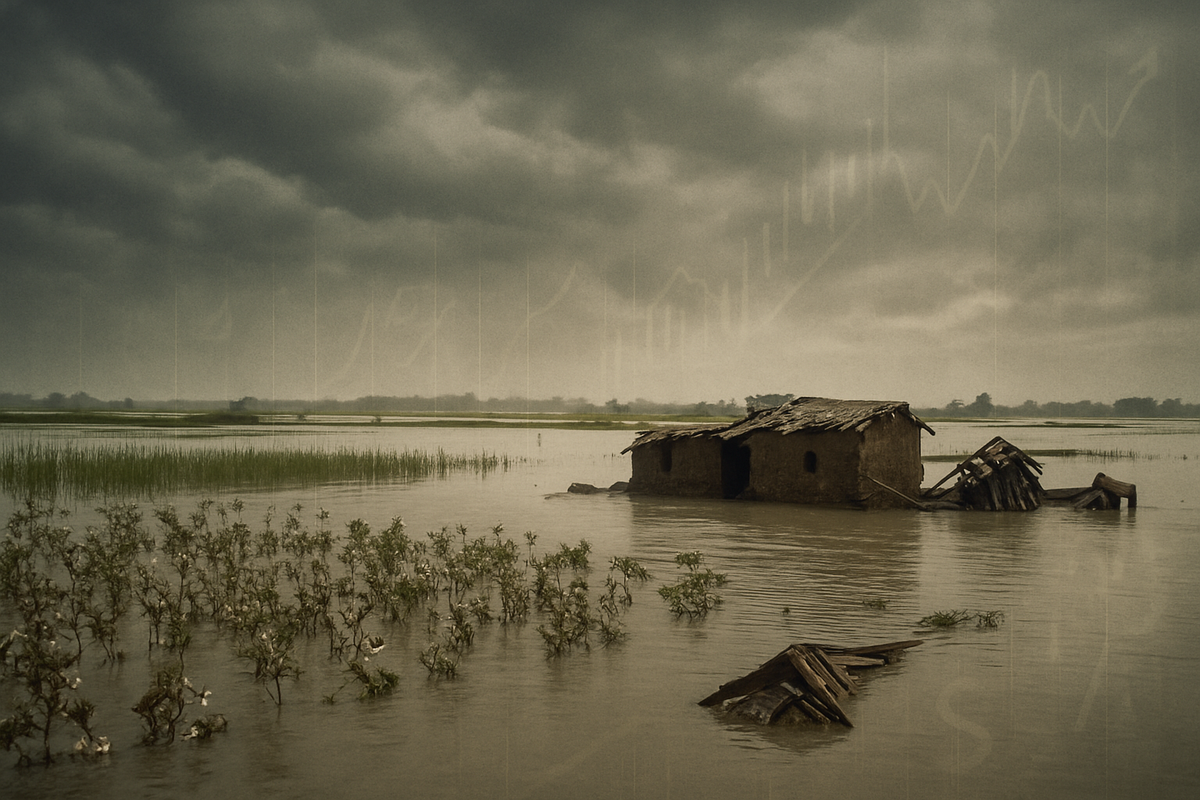
Pakistan, a nation acutely vulnerable to climate change, is once again grappling with the devastating aftermath of recent floods in 2025. These latest deluges, particularly impacting the agricultural heartlands of Punjab and Khyber Pakhtunkhwa, are projected to exacerbate already fragile food supply chains and fuel a fresh wave of inflationary pressures across the country. Coming on the heels of the catastrophic 2022 super floods, the recurring natural disaster threatens to dismantle the nation's efforts towards economic stabilization, placing immense strain on consumers and businesses alike.
The immediate implications are dire: widespread damage to standing crops, disruption of vital transportation networks, and a subsequent surge in the prices of essential agricultural commodities. For financial market participants, this scenario underscores the profound connection between environmental crises, global food security, and the stability of emerging markets, signaling potential volatility in commodity-linked investments and a challenging outlook for food-related industries.
A Nation Under Water: The 2025 Floods and Their Agricultural Toll
The 2025 monsoon season brought relentless heavy rains and subsequent river overflows, particularly affecting the populous provinces of Punjab and Khyber Pakhtunkhwa. While initial assessments from the Ministry of Food Security suggest that some major Kharif crops, such as maize, paddy, and cotton, may only experience an 8% to 10% loss in Punjab as many were nearing maturity, the localized damage is significant. The destruction of rice and cotton crops remains a considerable threat to Pakistan's export earnings, despite a relatively strong overall sown area for rice. However, the true impact on specific regions and smaller-scale farmers is often more severe than initial aggregate estimates.
This recent event echoes the catastrophic 2022 floods, which submerged a third of the country, impacting over 33 million people and causing an estimated $30 billion to $35 billion in economic damage. The 2022 floods obliterated approximately 4 million acres of crops, with Sindh Province alone losing 80% of its expected rice production, 88% of cotton, and 61% of sugarcane. The destruction of over 1.1 million livestock and critical grain storage infrastructure in 2022 set a dangerous precedent for the fragility of Pakistan's food system. The current 2025 floods, though perhaps not on the same national scale as 2022, continue to highlight the nation's extreme vulnerability and the persistent challenges in recovering from successive climate shocks.
Key stakeholders involved include the Pakistani government, particularly the Ministry of Food Security and the Finance Ministry, who are tasked with damage assessment, relief efforts, and economic management. Farmers, the backbone of Pakistan's agrarian economy, are on the front lines, facing crop losses and livelihood destruction. Consumers, especially those in low-income brackets, bear the brunt of rising food prices. Initial market reactions have been swift and concerning; officials from the Ministry of Food Security reported sharp spikes in key commodity prices in September 2025, with wheat prices surging by 63% in just two weeks. Tomato prices rose by 12%, and onions by 10%, indicating immediate inflationary pressures on staple foods.
Market Movers: Companies Facing Headwinds and Potential Opportunities
The recent floods in Pakistan are expected to create a challenging environment for several sectors, while potentially offering limited, albeit niche, opportunities. Given the research did not identify specific publicly traded companies, the analysis will focus on categories of businesses most likely to be affected.
Agricultural Producers and Exporters: Companies involved in the cultivation, processing, and export of key Pakistani agricultural products, such as rice, cotton, and sugarcane, are likely to face significant headwinds. Crop destruction directly impacts their output and revenue. For instance, any company heavily reliant on Pakistan's rice exports, which are crucial for the country's foreign exchange earnings, will experience supply chain disruptions and potentially higher procurement costs. Local agricultural firms, often unlisted, will bear the direct brunt, but larger, publicly traded food processing companies (e.g., those dealing in flour, sugar, or textiles) that source raw materials domestically will face increased input costs and potential supply shortages. This could compress profit margins and force them to pass costs onto consumers, further fueling inflation.
Logistics and Transportation Companies: The destruction of infrastructure, including roads and bridges, severely hampers the movement of goods. Companies specializing in logistics, trucking, and warehousing will experience delays, increased operational costs, and reduced efficiency. This disruption not only affects the delivery of agricultural produce to markets but also impacts the broader supply chain for other goods, potentially affecting companies like Pakistan National Shipping Corporation (PSX: PNSC) or local trucking and rail operators. Their ability to maintain timely deliveries will be compromised, leading to higher freight charges and potential revenue losses.
Food Retailers and Consumer Staples: Supermarket chains and food distribution companies will grapple with higher procurement costs for essential commodities and potential stock shortages. This could impact their profitability and force them to adjust pricing strategies, which in turn affects consumer purchasing power. While some larger retailers might have diversified sourcing, their reliance on local produce for staples makes them vulnerable. Companies like Nestle Pakistan (PSX: NESTLE) or Engro Foods (PSX: EFOODS), which have extensive local supply chains, might see increased operational costs and pressure on their consumer prices.
Potential Niche Opportunities: In the long run, companies specializing in climate-resilient agriculture technologies, advanced irrigation systems, and disaster-resistant infrastructure could see increased demand for their services. Additionally, firms involved in rebuilding efforts or providing agricultural insurance (if such a market develops significantly) might find new avenues for growth. However, these are often longer-term prospects, and the immediate impact remains largely negative for most traditional agricultural and food-related businesses.
Wider Significance: Climate, Commodities, and Global Food Security
The recurring floods in Pakistan serve as a stark reminder of the escalating global challenge posed by climate change, particularly its profound impact on agricultural commodity markets and food security. Pakistan's position as a significant producer of rice and cotton means that its internal agricultural crises have ripple effects beyond its borders, influencing regional trade dynamics and global commodity prices. The destruction of crops like rice not only threatens Pakistan's export earnings but can also tighten global supplies, contributing to price volatility in international markets.
This event fits into a broader industry trend of increasing climate-induced supply shocks to agricultural markets worldwide. From droughts in the Americas to heatwaves in Europe, natural disasters are becoming more frequent and intense, directly affecting crop yields and livestock. For financial markets, this translates into greater uncertainty in futures markets for agricultural commodities, impacting hedging strategies and investment decisions. The interconnectedness of global food systems means that a crisis in one major producing region can quickly translate into higher food prices globally, affecting inflationary outlooks for central banks and consumer purchasing power in distant nations.
Regulatory and policy implications are significant. There is an urgent need for Pakistan to invest heavily in climate-resilient infrastructure, including improved water management systems, early warning flood mechanisms, and drought-resistant crop varieties. International aid and financial institutions play a crucial role in supporting these efforts, highlighting the global responsibility in addressing climate vulnerability. Policies promoting diversified agricultural practices and sustainable land use are paramount. Historically, similar events, such as major droughts in Australia or floods in Southeast Asia, have consistently demonstrated the immediate and sustained upward pressure on global commodity prices and the subsequent humanitarian crises. The 2022 Pakistan floods, which led to historic inflation rates and severe food insecurity, serve as a recent and powerful precedent, underscoring the predictable, yet devastating, cycle that the 2025 floods threaten to perpetuate.
What Comes Next: Navigating a Volatile Landscape
The short-term outlook for Pakistan suggests continued volatility in food commodity prices, particularly for staples like wheat, rice, onions, and tomatoes. The immediate challenge will be to manage existing supplies, potentially through imports, to mitigate acute shortages and curb runaway inflation. The government's Finance Ministry projects consumer inflation for September 2025 to be between 3.5% and 4.5%, noting the economy is in a stronger position than in 2022. However, other analyses, like that from Insight Securities, project higher headline inflation, potentially reaching 5.1% to 7.0% for September 2025, driven by persistent food price surges. This divergence underscores the uncertainty surrounding the true economic impact.
In the long term, Pakistan faces the imperative of strategic pivots towards climate adaptation and resilience. This includes significant investment in water infrastructure, such as dams and improved irrigation systems, to manage both floodwaters and periods of drought. Developing and deploying climate-smart agricultural practices, including the use of flood-tolerant crop varieties and precision farming techniques, will be crucial. These adaptations require substantial financial commitments and technological transfers, potentially creating market opportunities for companies specializing in agricultural technology, water management solutions, and sustainable infrastructure development.
Potential scenarios range from a relatively contained impact, where the government's current economic stability allows for effective mitigation and a quick recovery, to a more severe outcome where prolonged supply chain disruptions and sustained high food prices lead to social unrest and further economic instability. The latter scenario could necessitate emergency food aid and significant international financial assistance. Market opportunities may emerge for international commodity traders able to supply Pakistan with essential food items, while domestic challenges will persist for local producers and consumers. The ability of the Pakistani government to implement effective disaster response and long-term climate resilience strategies will largely determine the nation's trajectory in the coming months and years.
Wrap-Up: A Resilient Nation, a Fragile Future
The recent 2025 floods in Pakistan serve as a poignant reminder of the nation's ongoing struggle against the relentless forces of climate change. The key takeaways from this event are clear: recurrent natural disasters pose an existential threat to Pakistan's agricultural sector, leading to severe disruptions in food supply chains and igniting inflationary spirals that disproportionately affect the most vulnerable populations. The country's economy, while showing some signs of stabilization post-2022, remains highly susceptible to these climate shocks, highlighting the fragility of its progress.
Moving forward, the market will remain highly sensitive to agricultural output reports, food commodity price indices, and the government's fiscal and monetary responses. Investors should closely monitor inflation data, particularly the Sensitive Price Index (SPI) and food inflation figures, as these will be critical indicators of economic health. The Finance Ministry's projections of moderated inflation will be tested by the realities on the ground. Furthermore, the effectiveness of government policies aimed at disaster relief, agricultural support, and infrastructure rebuilding will be crucial.
The lasting impact of these floods extends beyond immediate economic figures; it reinforces the urgent need for Pakistan to embed climate resilience into its national development strategy. For investors, this means acknowledging the heightened risk associated with traditional agricultural and food-related investments in vulnerable regions, while also recognizing potential long-term opportunities in climate adaptation technologies and sustainable development initiatives. What investors should watch for in the coming months are not just economic indicators, but also the progress of national and international efforts to build a more resilient Pakistan, capable of withstanding the inevitable future challenges of a changing climate.
This content is intended for informational purposes only and is not financial advice.





